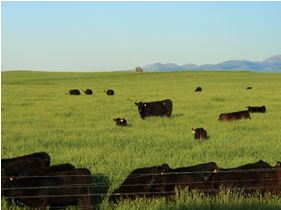



Using Genetics For Feed Efficient Beef Herds
With heritability at 40 per cent, residual feed intake is being studied by University of Alberta scientists to be factored into selection programmes.Researchers are looking at ways to use genomic technologies to select breeding animals in beef herds.
“Specifically we’re breeding for feed-efficient herds using estimated breeding values and genomically-enhanced estimated breeding values for (residual feed intake),” says Dr. Carolyn Fitzsimmons, a genetics expert at the University of Alberta.

Residual feed intake (RFI) is a measure of feed efficiency in livestock, and is the difference between feed actually consumed and feed required for growth and maintenance. Feed-efficient animals eat less than expected and have a negative or low RFI. Inefficient animals eat more and have a higher, or positive, RFI.
There is quite a bit of variation in RFI within breeds, and heritability is 40 per cent, so it’s a trait that seems to hold a lot of potential for improvement. Dr John Basarab and his colleagues began working on RFI in the early 2000s, and were the first to uncover the economic potential of selecting cattle based on RFI.
Dr Fitzsimmons and her colleagues are now focusing on the University of Alberta’s beef herd in Kinsella. One goal of the project is to show industry how genomics can be applied to breeding decisions.
*
"...for Charolais we won’t put as much emphasis on residual feed intake because they’re more of a terminal breed"
But they’re also looking at whether selecting for RFI affects other important traits.
Researchers split the main Kinsella composite herd into two equal herds to eliminate bias, adds Dr Fitzsimmons. “And then we had some control bulls for the control herd and what we have identified as efficient bulls for the efficient herd.”
Dr Fitzsimmons says they’re also trying to mimic how industry would select for RFI.
“We’re not just selecting for low RFI,” says Dr Fitzsimmons. “We’re making sure we’re keeping all the other important economic traits either equal or better than the control herd.”
The first steers from the program, now yearlings, are going through the GrowSafe system so researchers can measure RFI. Researchers have finished RFI evaluations on the heifers and will be analyzing the data and picking replacement heifers.
Researchers are also looking at purebred Angus and Charolais herds as part of the same project. The Angus herd will be evaluated for RFI, in the same way the Kinsella herd is being assessed.
“But for Charolais we won’t put as much emphasis on residual feed intake because they’re more of a terminal breed anyway,” says Dr Fitzsimmons. She adds they’ll focus on carcass traits using molecular breeding values.
Researchers are also comparing data collected from RFI testing to molecular breeding value from 50K SNP chips. Dr Fitzsimmons says comparing the data allows them to see whether molecular breeding values match what’s actually being measured.
“It’s all kind of contributing to improve molecular breeding values.”
But this isn’t the only project Dr Fitzsimmons has on her plate. She’s also looking at how maternal nutrition affects a calf’s gene expression, including growth and development, immunity and RFI. Check back later this month to read about that project.



